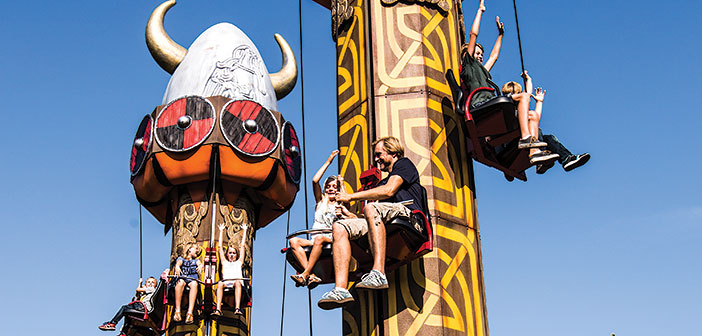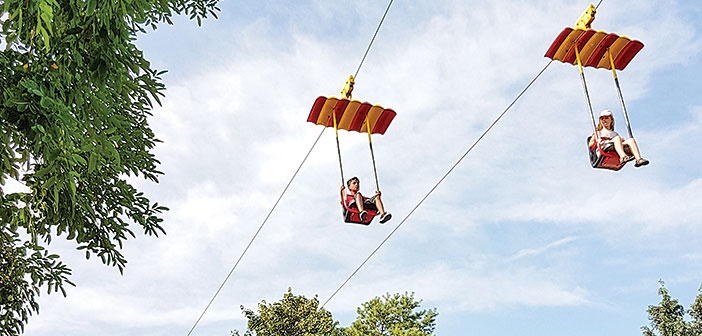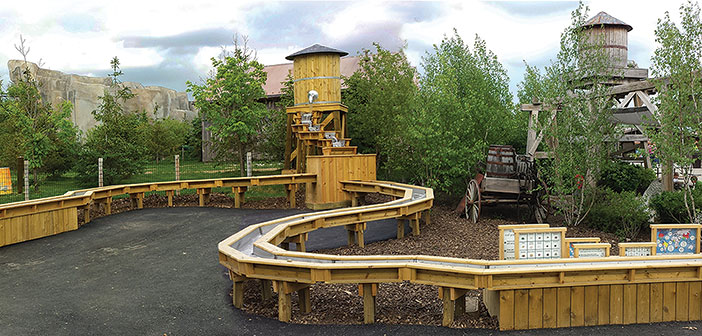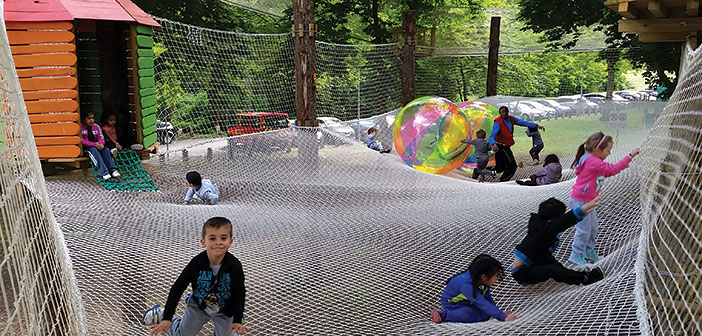As adventure parks flourish, operators are having an important realization: Nobody should put baby in a corner.
But since they also can’t allow baby to ride in a backpack with mom or dad down the zip line, the need for aerial adventure parks to have activities that appeal to a wide range of family members is key to not only getting folks there, but keeping them around. And while that notion extends to grandma and grandpa, perhaps the biggest challenge, and most in need of attention, is finding activities for smaller children.
European operations realized this long ago, and because of more relaxed regulations than one may find elsewhere, they’ve created elements and attractions that are open to the younger set. Here in the United States, it’s taken a bit longer, and still may need some work. That said, progress is being made.
Climbing for Kids
“We are always looking at adding elements for all different ages,” says Julien Hatton of Treetop Quest, which operates multiple adventure parks in America and also provides equipment to parks across the country. At each of its own parks, children 4 and up can now take part in the fun, on courses designed with them in mind.
Treetop Quest’s Chick Pea Course is a kid-friendly product that allows 4- to 7-year-olds to discover the fun of an adventure park, in an environment scaled to their size. Kids are hooked up to a continuous belay system, and the trolleys are lightweight to make travel through the course easier for smaller participants. Chick Pea obstacles are similar to the elements in the big course, but lighter and easier to use for little ones.

Kids’ courses that are low to the ground, like those at Treetop Quest, are a great way to introduce youth to aerial adventure.
Treetop Quest requires parents to supervise their kids, guiding them from the ground (the Chick Pea Course isn’t a babysitter). The elements allow kids to gain confidence, and eco-themed plaques throughout teach the young climbers about the environment. As important, the course gives little kids not just a feeling of inclusion, but a taste for outdoor active fun—queuing them up as customers of the future.
Treetop Quest has also introduced Spider Quest, a harness-free course with a giant safety net below. Adventurers have an hour to explore the 15 tree-to-tree obstacles as they climb, crawl, and swing through the course. In order to participate, kids must be at least 7 years old and able to comfortably reach up their hands to a height of 4’ 5” when standing flatfooted. Adults are encouraged to participate as well, or observe from the trails on the ground below.
Another harness-free installation from Treetop is the Hobbit Village. It includes a variety of things for little ones to explore, such as slides, low-impact obstacles, and treehouses—all set above, and around, a giant safety net.
For kids as young as 2-3 years old, Kiddie Quest is a fun outdoor activity. It offers a taste of adventure on a low, near-ground obstacle course as well as adventure games, activities, and recreational play equipment. Each mini element requires parental assistance, and helps tiny tots learn to maneuver; but most important of all, helps them have fun.
All of Treetop Quest’s products can be designed and built at other parks. Customer feedback, Hatton says, has been excellent. At Gunstock, N.H., where Treetop Quest installed a Hobbit Village, “they were really packed during the summer,” he says.
Of course, these installations can offer an ROI in addition to the benefit of attracting families and keeping them on-site longer so they spend more organically. Treetop Quest charges for using many of the attractions geared toward little kids. For instance, it’s a $5 fee to enjoy Kiddie Quest. But aside from the cost of installation, these kid-friendly courses have low operating costs, thanks to minimal staffing requirements.
Since all such projects are custom built, it’s difficult to give an exact estimate for build time and cost. But typically, Hatton says, a Hobbit Village with five treehouses would take around a month and a half to build and cost around $150,000. A small installation could run as little as $50,000, and a large Hobbit Village could cost as much as $350,000.
All told, investing in kids’ activities seems worth the cost. Hatton sees these types of attractions as an integral part to the general movement of what families are after. “People are looking to get back to the trees, to nature and to be challenged,” he says. “Making it so the entire family can enjoy it just makes sense.”
Easy Riders
Conor Rowan of Star Lifts USA says American adventure parks are still learning about catering to small kids. Star Lifts offers a variety of unique, yet practical, options that could make good additions to an aerial adventure park.
The Tower, for instance, is an interactive ride in which the participant pulls on a rope to control the speed, height, and movement of their carrier up and down the vertical structure. “You can make choices, so it’s a bit different from a ride,” says Rowan, and perfect for smaller kids.

“The Tower” from Star Lifts is a fun, practical, and kid-friendly addition to any park.
The company also offers the Sky Dive, which is a kind of junior zip line. A single-seat carrier is attached to a trolley that travels on a cable no longer than 150 feet long. The seat has a restraint bar to keep passengers in place. The entire ride offers “nothing crazy,” Rowan says, as it sits not too high off the ground and zips down and back—kids get on and off in the same spot.

Star Lifts’ Sky Dive.
Rowan says that the advent of more adventurous elements for smaller kids is slower, because rules and regulations can delay the process. Nonetheless, he says it’s important for operators to understand that what pleases a smaller child may not please an older one; and that’s okay, so long as there is something offered for all. Something like The Tower, he says, “Is not as exhilarating to a 15 year old as it is to a younger kid. But if you are a little kid? It’s awesome.”
Treasure Hunting
And then there are the simple pleasures—elements added to an aerial adventure park or resort that thrill in a totally different way and please all ages. The thrill of discovery is something we all enjoy. And, as many parks have discovered, panning for treasure at a mining sluice is one of the more inclusive, interactive, addictive—and profitable—activities out there.
A staple at spots like cavern tours, these long, sloping troughs carry flowing water, and guests use a sluice box to sift through raw mining material they purchase on site with the hopes of finding gemstones. Sluices are becoming more and more popular, and speak to all ages and interests. Justin Woodruff of Sandy Creek Mining Company knows this for sure.

Sandy Creek Mining sluices.
As adventure parks also grow in popularity, Woodruff says, operators are realizing they’re not just catering to thrill seekers. “This is a different kind of traffic we are seeing now,” he says. “Lots of day trippers and lots of multi-generational families.”
Sandy Creek Mining’s set-ups are low enough for any child who can stand (no one ever has to stand on a bucket, says Woodruff). And using them is simple.
“You don’t have to be an athlete,” Woodruff adds. “You just need to have a little curiosity. This is low tech. There are no flashing lights. It’s just simple fun. It’s about the fun of discovery.”
There are other benefits to the system as well, he says, like keeping folks busy, engaged, and happy on high-volume days, in much the same way that a climbing wall can be a good activity to keep people entertained while awaiting their turn on the zip tour or aerial park.
“We build these places up so fast with zip lines, and all of a sudden we have so many people there,” he says. “This is something where you can park a lot of people.” The advantage is, they are actually doing something instead of feeling “parked.”
So, do kids actually like this? The market studies and planning all say yes, but Woodruff got a more personal affirmation one day at the zoo—with his own kids, who are four and seven.
“I took them to the Columbus [Ohio] Zoo, and the kids went panning there. They just went nuts for it,” he recalls. “Like it was the greatest thing that ever happened to them in their lives. They were all excited to discover it, and I was like, ‘You do know what daddy does, don’t you?’”
From easy-to-access obstacle courses to tiny zip lines and sluices, parks are beginning to give little ones a more active way to be part of the fun. And that, says Woodruff—the businessman and the dad—is great for everyone.
“When the kids are happy, the whole family is happy,” he says.



